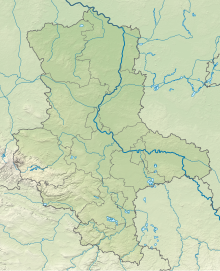Gypsum karst landscape Questenberg
Coordinates: 51 ° 30 ′ 8 ″ N , 11 ° 7 ′ 25 ″ E
The Questenberg gypsum karst landscape is a nature reserve in the communities of Südharz and Berga and the town of Sangerhausen in the district of Mansfeld-Südharz in Saxony-Anhalt .
The nature reserve with the registration number NSG 0166 is around 3891 hectares . It is part of the FFH area "Red sandstone and gypsum karst landscape near Questenberg in the southern Harz" and is largely surrounded by the "Harz and Vorländer" conservation area. The area has been under protection since 1996 (date of regulation: June 26, 1996). The “Bauerngraben” and “Mooskammer” nature reserves, designated in 1961, have merged into it. The responsible lower nature conservation authority is the district of Mansfeld-Südharz.
The nature reserve extends along the southern Harz Zechstein belt between Uftrungen , a district of the southern Harz municipality in the west and Wettelrode , a district of Sangerhausen in the east. It is completely located in the Karst Landscape South Harz Biosphere Reserve and in the Harz / Saxony-Anhalt Nature Park . It protects part of the southern Harz Zechstein belt with pronounced karst features, natural forests and old copper slate heaps. Among the karst formations in the nature reserve include sinkholes , sinkholes , sink-holes - as Dinsterbachschwinde and Anke Mountain Schwinde - karst springs , sunken Karst Waters transverse valleys of Wet between Questenberg and Wickerode , the leash at Großleinungen and other, now mostly completely dry transverse valleys and the south-east of Breitungen at the foot the episodic lake lying on the Wurmberg as the largest episodic gypsum karst lake in central Germany. The lake is located in the Bauerngraben , a 350-meter-long and 100-meter-wide shrink basin. The Glasebach flows into it from the north . Abandoned quarries can also be found in the nature reserve.
The forest communities in the nature reserve are dominated by beech and oak forests. For example, hornbeam and woodruff red beech forests , sedge-red beech forests , species-poor karst beech forests and, on southern slopes, warm-loving forest rennet, sessile oak and hornbeam forests occur. Moist and shady slopes are of ash sycamore - Gorge Forest ingested. At the forest edge locations falter wild service trees - and dyer's broom -Eichenwald.
On exposed in northern directions sites are gravel fields and rocky Heiden to find on exposed in southern directions drylands milkwort - Blue Grass -Halb dry grass and plant of the spurge heather heaths and orchards with Furchenschwingel- Fiederzwenken -Halbtrockenrasen and oat reported and fertilized meadows and aphanes - Chamomile societies on field margins . Relics of the earlier copper slate mining are numerous heaps . Here, have heavy metal lawn and copses settled.
Rare mushrooms , ferns in sinkhole walls and lichens on rocky knolls settle in the nature reserve . Species that are particularly worthy of protection are spotted arum , common daphne , Turkish lily , German fringed gentian , diptame , numerous types of orchids as well as deer-tongue fern and earth stars. The nature reserve is home to numerous birds , including the stock dove , middle woodpecker , black woodpecker and willow tit , which find their habitat in the forests, wrynecks and red-backed shrimp as representatives of the semi-open landscapes and dipper , kingfisher and gray wagtail in the water area. Brown trout and bullhead are native to the rivers and streams . Amphibians are z. As by fire salamander , tree frog and various species of newts , reptiles by adder , slow worm , ringed and smooth snake represented. The tree hollows of the forests provide a habitat for various bat species , including the brown long-eared bat and the fringed bat . Other bat species find suitable habitat in the karst caves. The nature reserve is also a habitat for pine marten , badger , wildcat and dormouse, as well as various grasshoppers and butterflies .
A 12 hectare area in the west of the nature reserve is designated as a natural forest cell Uftrunger Seeberge and left to its natural development.
District road 2306 crosses the nature reserve southeast of Hainrode . A section of the southern Harz karst hiking trail runs through the nature reserve .
Web links
Individual evidence
- ^ Ordinance of the Halle regional council on the establishment of the nature reserve “Gipskarstlandschaft Questenberg” , district of Sangerhausen (PDF file, 55.1 kB). Retrieved April 13, 2018.
- ^ Location Queste , Karst hiking trail Südharz. Retrieved May 23, 2014.
- ↑ The breakthrough valley of the Nasse near Questenberg , natural phenomena in the biosphere reserve, the karst landscape of the southern Harz biosphere reserve. Retrieved May 23, 2014.
- ^ Location Drebsdorfer Flur , Karst hiking trail Südharz. Retrieved May 23, 2014.
- ↑ Location dry valleys , karst hiking trail Südharz. Retrieved May 23, 2014.
- ↑ Location Bauerngraben , Karst Hiking Trail Südharz. Retrieved May 23, 2014.
- ↑ Profile of the Uftrunger Seeberge natural forest cell , database of natural forest reserves in Germany, Federal Agency for Agriculture and Food. Retrieved May 23, 2014.
- ↑ Overview map of Mansfeld-Südharz district , Karst hiking trail Südharz. Retrieved May 23, 2014.





